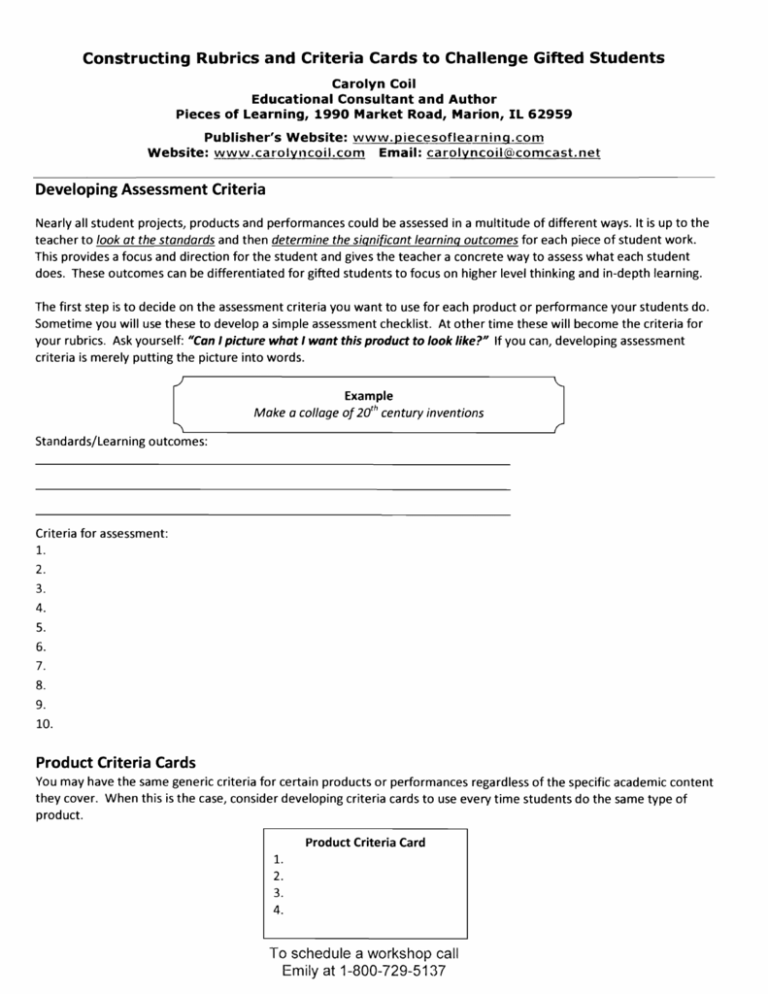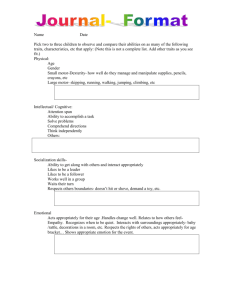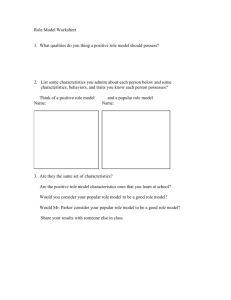Constructing Rubrics
advertisement

Constructing Rubrics and Criteria Cards to Challenge Gifted Students Carolyn Coil Educational Consultant and Author Pieces of Learning, 1990 Market Road, Marion, IL 62959 Publisher's Website: www.piecesoflearning.com Website: yvw\,.v.carQ1.Y!lcoil.com Email: carolyncoil(rucomcast.net Developing Assessment Criteria Nearly all student projects, products and performances could be assessed in a multitude of different ways. It is up to the teacher to look at the standards and then determine the significant learning outcomes for each piece of student work. This provides a focus and direction for the student and gives the teacher a concrete way to assess what each student does. These outcomes can be differentiated for gifted students to focus on higher level thinking and in-depth learning. The first step is to decide on the assessment criteria you want to use for each product or performance your students do. Sometime you will use these to develop a simple assessment checklist. At other time these will become the criteria for your rubrics. Ask yourself: "Can I picture what I want this product to look like?" If you can, developing assessment criteria is merely putting the picture into words. Example th Make a col/age of 20 century inventions Standards/Learning outcomes: Criteria for assessment: 1. 2. 3. 4. 5. 6. 7. 8. 9. 10. Product Criteria Cards You may have the same generic criteria for certain products or performances regardless of the specific academic content they cover. When this is the case, consider developing criteria cards to use every time students do the same type of product. Product Criteria Card 1. 2. 3. 4. To schedule a workshop call Emily at 1-800-729-5137 Product Criteria Cards Brochure 1. 2. 3. 4. Pictures relate to topic Attractive and neat layout Folded with information on each panel Neat and clear writing highlighting important points 5. Correct spelling Cartoon 1. 2. 3. 4. 5. Conveys a message Clear writing with correct spelling Neatly drawn Humorous Creative and original Chart 1. 2. 3. 4. 5. Well-organized sections divided by lines Clear and neat writing Has a title and sub-titles Accurate information Correct spelling Collage 1. 2. 3. 4. 5. Has a solid backing Visually attractive and neat Pictures overlap Creative and Original Has title/labels spelled correctly Comic Book/Comic Strip 1. 2. 3. 4. 5. 6. Frames in correct sequence Tells story or idea through pictures Characters/objects clearly drawn Clear writing with correct spelling Humor Original and creative Concept MaplWeb 1. Has major topic in center 2. Shows details about the topic with lines and/or circles radiating from the center 3. Visually shows relationships of details or ideas to one another 4. Neat and legible Crossword Puzzle 1. Each word intersects with another in at least one space 2. Correct spelling 3. Accurate definitions indicating across and down 4. Neatly and clearly done Diorama 1. Realistic depiction of scene 2. Sides have background scenery 3. 3-dimensional figures/objects in fore­ ground 4. Durable construction 5. Accurate Drawing 1. Pictures are clear and understandable 2. Neatly done 3. Shows topic accurately Flowchart 1. Has items in sequential order 2. Shows relationship between items by use of arrows or lines 3. Labels and items are neatly written 4. Short explanation of each item © Pieces of Learning 21 Taken from Activities & Assessments for the Differentiated Classroom by Carolyn Coil ©2004 Writing Rubrics A rubric is a ser of descriptive guidelines used to assess and give scores to student work. Complex rubrics come with boxes and descriptors for each level. A typical complex rubric: • Contains a scale of possible points and lor categories to be assigned for varying degrees of mastery or quality. • States the different traits or criteria to be examined in the product or performance. • Provides pOinters for assessing each of the traits and finding the right place on the scoring scale to which a particular student's work corresponds. Students should know exactly what the criteria and rubrics are, and teachers ought to be teaching directly to these criteria if the outcomes inherent in the task are worthwhile. Criteria cards can be included as one of the items in the rubric. With gifted and other high ability students, always include an extension column in your rubric. This indicates that there is more they can do and learn the specific assignment requires. A good rubric helps teachers grade all types of products and performances more fairly since rubrics require teachers to be much more precise about what their expectations are. Rubrics give students an understanding of the meaning behind the grade. Rubrics can be developed by the teacher or by the students themselves. Developing the rubric is a great way to show students what makes an excellent product or performance. A generalized example of a scoring scale with performance levels and standards is as follows: = The learning activity I project was attempted, but it was not done correctly or completely. 2 =The learning activity I project was worked on, but it needs redirection, more detail, more information or 1 different strategies and approaches. 3 = For the most part, the learning activity I project was completed. Minor problems remain. 4 = The learning activity I project was fully accomplished and done well. 5 = The learning activity I project was fully achieved and extended beyond the requirements or standards. In this scale, 5 is especially important for gifted and high achieving students who always get A's on assignments without putting forth much effort. This challenges them to think and learn at a level appropriate for them. Guidelines for a Good Rubric: 1. 2. 3. 4. 5. Is understandable to the student Can be used by the student as a guide for doing quality work Challenges students to go beyond expectations or standards Can be used by the teacher to grade coherently and fairly Can be used to defend the grade if questioned by a student or parent Suggested Points for Rubrics Make sure your pOints work so that you give students a passing grade when they turn something in and you have accepted it. In a rubric with four assessment criteria and five columns, you may want to make the "1" column worth 15 pOints for each block (60 total), the "2" column worth 18 pOints for each block (72 total), the '3' column worth 21 points for each block (84 total), the "4" column worth 24 pOints for each block (96 total). Use the remaining 4 pOints for the extension column (100 total). Suggested Resources from Pieces of Learning (Visit our conference Exhibit Booth) Product Criteria Cards by Carolyn Coil & Dodie Merritt Products Tool Bag - K-l, 2-3,4-5 by Joan Brownlee Solving the Assessment Puzzle by Carolyn Coil & Dodie Merritt Successful Teaching in the Differentiated Classroom by Carolyn Coil From a workshop by Carolyn Coil Pieces of Learning publisher: \-800-729-5\37 Website: \\ \'. .1';"ll';,Jic',;! 1)1:>,111' Rubric - Chart of Character Traits: Greek God or Goddess and Famous Person Today NAME: DATE: Standard 1/ Outcomes: 1. Show u nderstanding of how Greek mythology has made an npact on current thinking. 2. Analyze character traits of a character in a Greek myth. 3. Organ e, write, and present ideas. C R I T E R I A Identifies Greek god/goddess and famous person of today and lists similar character traits. Gives examples of each trait for both the Greek god/goddess and the famous person of today. Indicates which traits are strengths and which are weaknesses. Follows Chart criteria card. 1 2 Identifies only Identifies god or goddess god/goddess but not famous and famous person and 1-2 person. 1-2 character traits. character traits. Has 1-2 examples for famous person or the god/goddess but not both. Indicates strengths or weaknesses for 1-2 traits but doesn't explain why. Has 1 item on criteria card. Has 1-2 examples for famous person and the god/goddess. Indicates strengths or weaknesses for 1-2 traits and explains why. Has 2 items on criteria card. 3 4 Identifies god/goddess and famous person and 3-4 character traits. Has 3-4 examples for famous person and the god/goddess. Identifies god/goddess and famous person and 5 or more character traits. Examples for each ofthe 5 or more traits for god/goddess and for famous person. Explains each of the 5 or more traits as a strength or weakness and indicates why. Indicates strengths or weaknesses for 3-4 traits and explains why. Has 3 items on Has all 4 items on criteria criteria card. card. Grade @ 2007 Pieces of Learning CLC0335 Successful Teaching In the Differentiated Classroom www.plecesoflearnlng.com 5 Extension Everything in #4 PLUS identifies unusual/unique traits that both have. Gives little known examples; links traits of both in uncommon ways. Explains each of the 5 or more traits as both a strength and a weakness and indicates why. Visually striking chart; extremely detailed and understandable.








